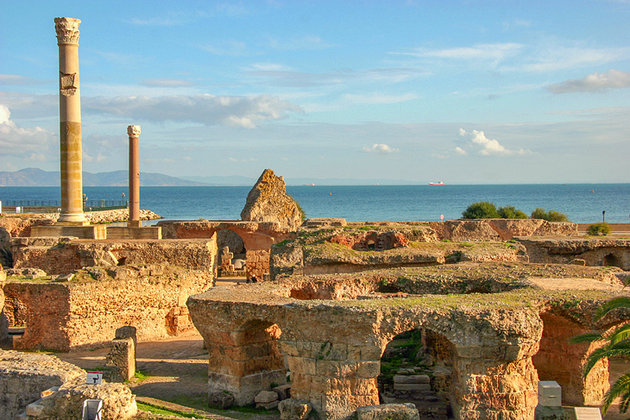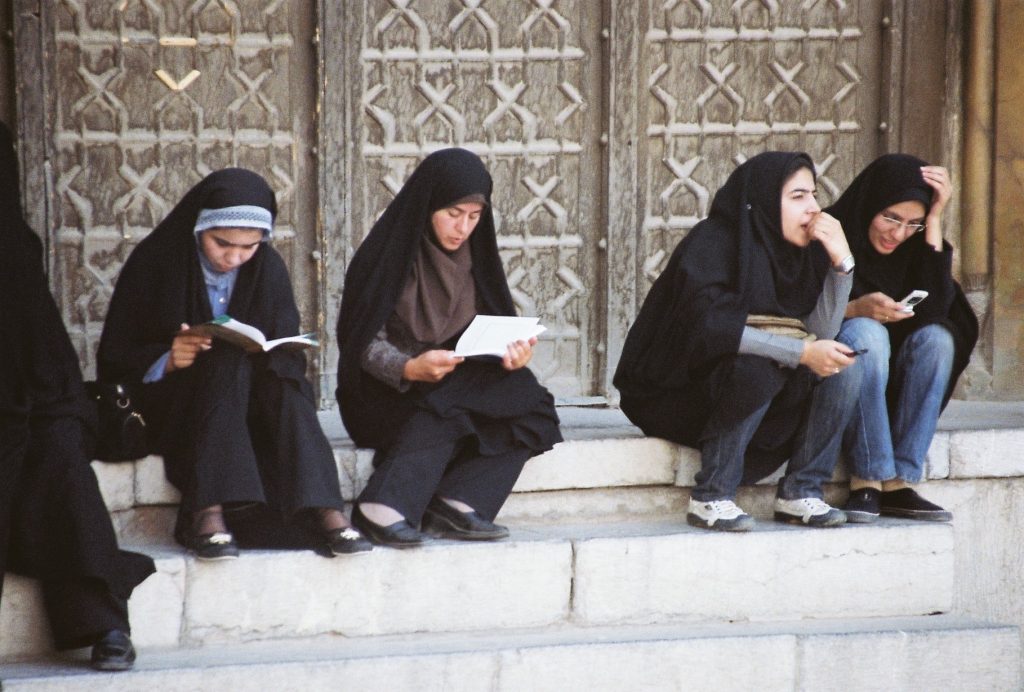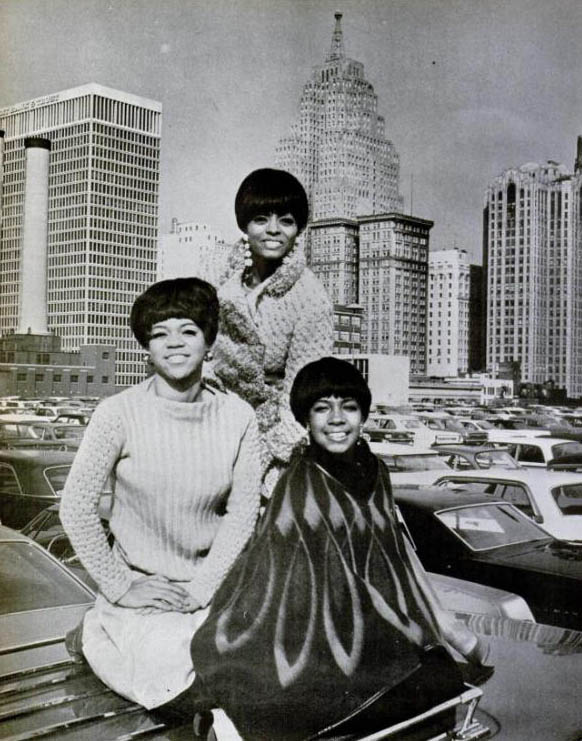“A Box of Coins,” nonfiction by Elizabeth Kostova, appeared in MQR’s Summer 2005 issue.
*
In May of 1944, my uncle, Paul Howard Johnson, found himself standing among the ruins of ancient Carthage. He was nineteen, a skinny, good-looking kid from Norwegian Brooklyn; his family were hardworking people, cabinetmakers and pile drivers who freckled or burned in the sun. He had never previously been farther from home than Syracuse, New York. In January 1942, Paul and his best friend from high school had signed up with the Air Force, partly from a profound sense of duty toward their country and the embattled Allies, and partly because the Air Force and Navy officers in a magazine advertisement for Webster’s cigars looked so dashing in their uniforms, each with a beautiful girl on his arm. Paul signed up the minute he was old enough, held his breath while the Air Force physicians decided whether or not the rheumatic fever he’d had at twelve would keep him out. It didn’t. After a year and a half of training, he joined the crew of a B-24 bomber and flew to Italy, stopping briefly at the El Aouina air base near Tunis.
Lieutenant Johnson was interested in the history of the Mediterranean, and he used his day off in Tunis to travel by interurban trolley to the village of La Goulette, close to the site of ancient Carthage. “The ruins were unimpressive,” he told me years later. “Mostly a lot of holes in the ground.” What did impress him was the wreckage of Rommel’s Afrika Corps, defeated the year before. Bits of airplanes decorated with swastikas lay scattered on the Tunisian desert. “They reminded me that we were headed for trouble.” While he was in the ruins he bought a handful of antique coins from an Arab kid. Fifty years later he gave the coins to me. We had always been close; he was unmarried and childless and we shared a love of books, of history. When he handed the coins to me, in a box, and told me what they were, I couldn’t speak for a moment.
Carthage was a Phoenician settlement, one of the great sites of the ancient world, and one of those most heavily trampled by war. The city lies at a strategic point on the north coast of Africa, looking out into the Mediterranean and triangulated with Sicily and Sardinia, which were for centuries among its colonies. My uncle, in high school in Brooklyn, had read about Carthage in Emil Ludwig’s classic The Mediterranean. That area of the African coast was populated more than four thousand years ago by Berbers, an ethnic group still in evidence there, and became an important trading area for Phoenician merchant ships around 1100 B.C.
The traditional date for the founding of the city of Carthage is 814 B.C., sixty-one years before the founding of Rome, which lay north across the Mediterranean. According to legend, its founder was a princess from Phoenician Tyre, Elissa, later called Dido. After her brother, the king of Tyre, murdered Dido’s husband, she fled with some followers first to Cyprus and then to the north African coast. The local king allotted her an area of land the size of an ox-hide, whereupon she cut the hide into strips and outlined a plot large enough to enclose an entire fortress. When the king insisted she marry him (out of admiration for her cleverness?), she pretended at first to acquiesce, then arranged to throw herself on a burning pyre. The poet Virgil added a lover, Aeneas, to the story. Dido is also commemorated in operas by Purcell and Berlioz and works by Chaucer and Marlowe. The city she established was a great Mediterranean power until its utter destruction in 146 B.C.
There are twenty-one coins in the collection my uncle bought from that Arab boy. Most of them are copper or bronze, and many are lettered in Latin with a head — usually in profile — on one side, and various symbols on the other; a few of the most worn coins bear the figure of a horse or other animal. Two of the coins are silver. Two are covered with Arabic script. One has a full-frontal figure with crown and scepter on one side and a Byzantine cross on the other. One shows the ancient symbol of Venice, the Lion of Saint Mark, with his gospel in his paw. Venetian artisans around the Mediterranean who depicted the Lion on coins and stone gateways showed him with an open book if Venice was at peace, and a closed book if she was at war—on this coin, the book is closed. One of the coins that is most rubbed and worn is more than a quarter-inch thick. When you hold it between your thumb and forefinger it feels softened to a silky finish; the animal on it is almost unrecognizable. The one silver Roman coin, on the other hand, shows the head of an emperor — “ANTONINUS,” it says — in exquisite detail, the spiky points of his crown so sharp that they could have been minted last month.
My uncle kept the coins in a tin box, which he also gave to me. The box is a souvenir of the English royal goodwill tour of the U.S. and Canada early in 1939. The photograph on its lid shows a hopeful-looking royal family in faded black and white; England was drumming up support for the enormous conflict to come. My uncle carried this box wherever he moved, throughout his career — to the Voice of America in New York, to graduate school at Columbia University, to a post as a librarian at Yale. If he had not survived the war, would the coins have been returned to his parents with his other possessions? Every now and then I take out the coins and hold them, and think about all the hands they have passed through.
By the sixth century B.C., a flourishing Carthage had tangled with both the Greeks and the Etruscans, taking considerable territory from each empire. She had also attracted the enmity of a rising power, Rome. Rome coveted Carthage’s wealth, her strategic location, her lucrative colonies. Roman generals and engineers frequently set their sights on the enormous walls of Carthage, which had shielded her successfully for two hundred years and would protect her for another five hundred, although her naval fleet suffered catastrophic defeats. The Punic Gods — Baal Hammon and Tanit — demanded a high price for the city’s continued safety, however; in the Tophet, the place of ritual human sacrifice, hundreds or perhaps thousands of babies and small children were thrown into a fiery pit between 700 and 146 B.C.
My uncle had always meant to find out more about the coins, and I wanted to find out something for him. Last fall, nearly sixty years after his visit to Carthage, I took the whole box to a specialist at the Kelsey Museum of Archaeology at the University of Michigan. They have no numismatics curator, but Robin Meador-Woodruff, the museum’s curator of photographs, met with me in her pleasantly cluttered office on the second floor. She was a friendly woman with thick blond hair, dressed in denim. On her desk I could see pictures of her with her baby. I showed her my uncle’s letter about the provenance of the coins and she smiled. “Actually, the university excavated near La Goulette in 1924 and 1925,” she said. “A Punic site. We went back in the 1970s for a fiftieth-anniversary dig.” I wondered if some of those holes in the ground my uncle had found unimpressive had been dug by the Michigan team twenty years earlier. I asked her whether there were many coins in the museum’s collection and she smiled again. “We have 100,000 objects, counting coins and photographs — about 50,000 of our objects are coins.”
She told me, too, that coins are elusive artifacts to study because they drift so easily across national borders, making their histories hard to trace. Even if you dig up an actual hoard of coins, they may have traveled considerably before they were hoarded. In addition, there are two kinds of coin hoarders. One kind hoards against hard times, choosing them mainly for the value of their ore. The second kind is a collector. “There were coin collectors in antiquity, too,” she explained. “They tended to select good examples, paying attention to rareness or variety and to the condition of the coins. Because of this, you sometimes find beautiful collections that have been preserved from the wear of the earth — in urns, for example — but most coins go through a lot.”
She also told me that since 1978 it has been illegal to take antique artifacts out of the countries where they are found, according to a UNESCO agreement — ratified in Tunisia as Law No. 86-35 of 1970, which protects “registered archaeological movables which consist of works created and produced or constructed by man at least 100 years ago as well as those of historic or prehistoric significance.” This law is frequently ignored or broken and is very hard to enforce in the case of coins. But if my uncle had bought the coins last year, they might have been taken away from him at the border.
I showed her the coins in their box, and she carefully removed one, then set it down, went to another office, and brought me back a stack of plastic coin mounts and small squares of paper to label them. The first coin she examined was Roman, the only one of the collection that shows the head of a woman, a gentle profile with a heavy knot of hair at the nape of the neck. The reverse bears a standing figure in long robes, also apparently a woman, one graceful arm extended and the other holding something. The profile is lettered FAVSTINA, but the words around the standing figure are too worn to read.
Ms. Meador-Woodruff examined the coin carefully. “Well, there were three Faustinas in Roman history,” she said, pulling down a reference book. “But I’d say this dates from about A.D. 165.” She picked up another coin. “Remember, these are educated guesses.” As she turned through the coins, however, I could see how highly educated her guesses were. She identified fourteen of them as Roman and dated some of them from the Republic — “Before Augustus made himself Caesar,” she explained — some from the early Empire, and some from the very late Empire.
Many of the other coins she thought could be Greek. “The Romans used their money for propaganda, so there’s a lot more lettering on them, but the Greeks had aesthetic priorities, so you see a lot of animals and they have this wonderful sculptural quality, and they’re often thick, like this. But I don’t know if these are all Greek — or Hellenized — they’re mostly so worn it’s hard to tell.” She couldn’t read the Ottoman coins, but the silver one had been struck off-center—a sign, she said, that it might be much older than the neatly minted copper one. She guided me to coin books, gave me clues, set me on my path. I was amazed by how much she read from them in an hour.
At one point, I asked her if the coins had much monetary value and she shook her head; they were too common, and mostly in poor condition. “But they have great value for you.”
“Yes, they do,” I said.
My uncle’s unit settled in the heel of Italy, across the Mediterranean from Carthage, and from there he flew thirty-two missions, bombing southern France, southern Germany, Austria, the Balkans, northern Italy. You didn’t expect to survive, he told me; you just hoped to. Fifty missions was a complete tour of duty, and then you could be discharged, although some men chose to begin a second tour. My uncle still talks about the wonderful olives grown around Lecce, the warmish showers the pilots rigged for themselves on the roofs of the old buildings, the ration of whiskey you got after each mission, the friends who didn’t make it back to base. He didn’t usually fly the plane, although he’d been trained in aviation; his job as bombardier was to send their load to its targets — Axis factories, air bases, oil fields, ports.
I found Faustina Junior in a dictionary of Roman coinage. She was a daughter of the emperor Antoninus Pius and Faustina Senior. I could see from photographs of coins depicting Faustina Senior — and also some depicting an earlier Annia Faustina — that my uncle’s Faustina was certainly the Junior, as Ms. Meador-Woodruff had guessed. The lettering of her name on the coin in the book was nearly identical, and the mild face and hair style were extremely similar. Faustina Junior married Marcus Aurelius in A.D. 145. She went with him on his travels east in 175 and died at the foot of the Taurus Mountains (present-day southern Turkey). I thought of her dying in a remote village; she had been the mother of many children, a devoted wife who had traveled far from home on campaign with her philosopher husband, and ultimately a casualty of war. Like many emperors, Marcus Aurelius had issued coinage in commemoration of his dead empress.
I couldn’t find a photograph of a Faustina Junior coin with exactly the same reverse image, but I discovered a very similar graceful figure, the details of its draperies intact — Diana, beautiful goddess of the hunt, with her bow in one hand and her arrow in the other. The outline of the gown was the same, anyway, and above all the ineffably sweet gesture of her arm. Faustina Junior had been brave and adventurous, too, and sweet, judging from her profile, and perhaps Marcus Aurelius had chosen this image especially for her. Turning over the other coins, I realized that each must have a story as rich as this one.
On August 15, 1944, at two in the morning, my uncle’s plane blew up on the runway during takeoff. It had been sabotaged, the engine rigged to a bomb by Italian spies or American turncoats — the Air Force was never able to ascertain who’d done it. “Though seriously injured in the crash,” ran the report of my uncle’s award of the Soldier’s Medal, “hearing cries for help from an injured crew member, Lt. Johnson immediately went to his aid. Despite intense heat from the burning plane, together with the imminent danger of explosion, displaying outstanding courage and determination, he successfully extricated the injured crew member and carried him to safety.” The Soldier’s Medal was followed by a Purple Heart, pinned to his undershirt in the hospital.
When he was well enough, my uncle went back to New York and began his life. He worked for the Voice of America; he studied Milton. Ultimately he became a librarian, a keeper of books, and a museum curator, a keeper of history. His interest as a curator was the history of the Coast Guard, the only branch of the American military dedicated entirely to search and rescue.
From 264 to 241 B.C., the First Punic War between Rome and Carthage raged on land and sea; it ended when Carthage traded Sicily for peace. From 218 to 202, the Second Punic War was fought mainly by an extraordinary last-minute leader of the Carthaginians, Hannibal, son of Hamilcar Barca. In a feat of military strategy that is possibly the most admired in history, he crossed the Alps with a large army that included elephants and sneaked up on Rome from behind. Hannibal won staggering victories on this campaign but was beaten in 202 B.C. by the Roman general Scipio and went into exile soon after. In 149 B.C., the Romans began a three-year siege of the fading city, destroying it completely in the spring of 146. Carthage fell to sabotage; spies within the walls had given her away. Legend has it that the Romans sowed the very fields of the region with salt, that nothing might grow there again. Carthage’s last queen died like her first, casting herself and her children into a burning temple. The fire that consumed the city raged for ten days, and can still be seen in the form of a widespread archaeological layer of carbon.
My uncle turned eighty-one in January. He said to me a few years ago, “I wish I could just finish thinking about that war and get it out of my system.” For his sake, I wish he could, too. Selfishly, I’m glad he hasn’t. When I take the tin box from my desk drawer and open it, I can see him standing among the excavations, the layers of life and destruction. He is very young; there’s no shrapnel in his leg yet. He gives the Arab boy a couple of bills and the boy gives him a handful of coins. Maybe my uncle stands there turning through them for a minute, seeing Latin letters, imperial profiles, archaic horses. His hand is freckled.
Image: The ancient ruins at Carthage.




